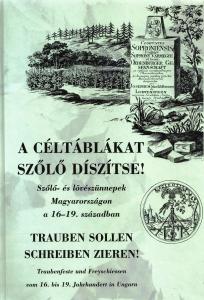
Decorate the Shooting Targets with Grape!
Decorate the Shooting Targets with Grape!
Grape and shooting festivals in Hungary between the 16th and 19th centuries
Compilation and translation of German texts: József László Kovács
NSZL, Budapest, 2009., 268 pages
ISBN 978 963 200 564 5
This volume edited by József László Kovács is a collection of the history and customs of the one-time shooting festivals of Hungarian town citizens and peasants. The documents that mainly come from the NSZL collections reveal many interesting and graceful details.
Historical shooting associations originally had three duties: to defend the city, to use the knightly weapons and to add splendor to religious ceremonies. The first written regulation of a target shooting contest in the city of Sopron was issued in 1542. The book was so frequently used that it had to be re-published in 1577. During the 17th century, a number of amendments were added.
From the 16th century onwards, shooting associations organized festivals each year with the participation of Hungarian and foreign shooters who were enumerated in alphabetical order and written a poem about. Johann Fischart, 16th century Swiss poet, described the popular character of these events in his poem Glückhaft Schiffart. The most important literary memory of target shooting in Sopron is Ferdinánd Dobner’s booklet Frey- und Trauben-Schiessen (Regensburg, 1698). Alongside the descriptions, the author also presents four grape decorated emblems in his work.
In wartime, shooting associations were usually reorganized. It also happened during the Napoleonic wars, when the reorganization of the Sopron shooting association took place. According to the 1542 regulation of Sopron, also the Catholic Altar associations had to transform into shooting associations in wartime. The regulation sets the exact rules for knightly tournaments with guns, describing the types of bullets to be used, the participation fees, the expected behavior of the participants, and the rights of the master gunner in charge.
From the end of the 18th century, shooting associations mostly assumed decorative roles in festive parades and religious ceremonies. The Budaörs shooting association was founded explicitly for this reason in the 1870s, and its members paraded in fine uniforms on church processions until 1944.
Shopping
Our publications are available in our bookshop, or can be ordered from the Publications Department of the NSZL using the contact details below: Főigazgatói Kabinet kiadványtára, Országos Széchényi Könyvtár, 1276 Budapest P.O. box 1205., phone: 06-1-23-23-506, e-mail: kiadvanytar@oszk.hu.




